Safety, Health and Welfare at Work (General Application) Regulations 2007
F83 [ Schedule 11
Regulations 178 and 179
Artificial Optical Radiation ]
F83 [ Part 1
Non-Coherent Optical Radiation
The biophysically relevant exposure values to optical radiation can be determined with the formulae below. The formulae to be used depend on the range of radiation emitted by the source and the results should be compared with the corresponding exposure limit values indicated in Table 1.1. More than one exposure value and corresponding exposure limit can be relevant for a given source of optical radiation.
Numbering ( a ) to ( o ) refers to corresponding rows of Table 1.1.
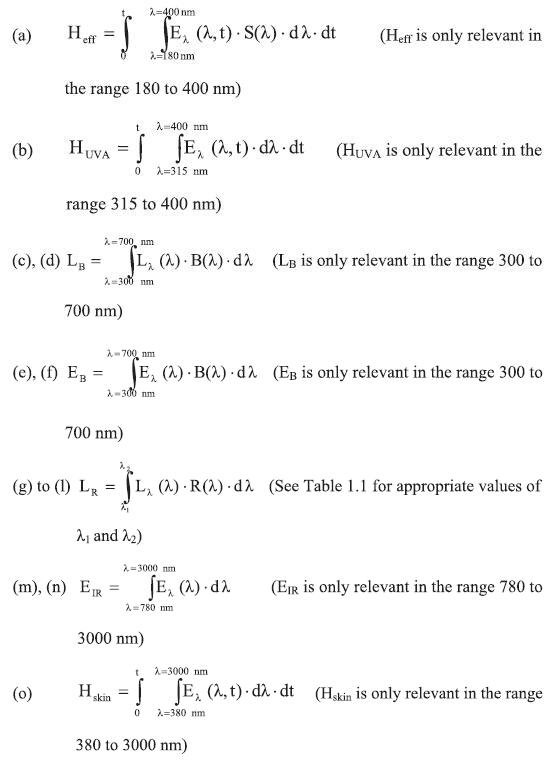
For the purposes of these Regulations, the formulae above can be replaced by the following expressions and the use of discrete values as set out in the following tables:
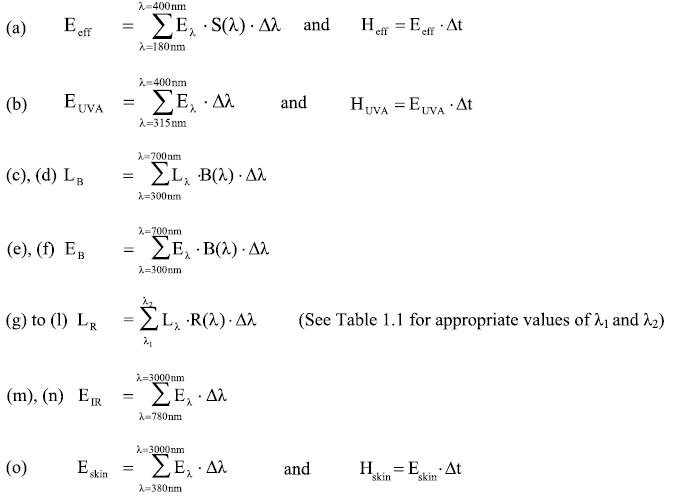
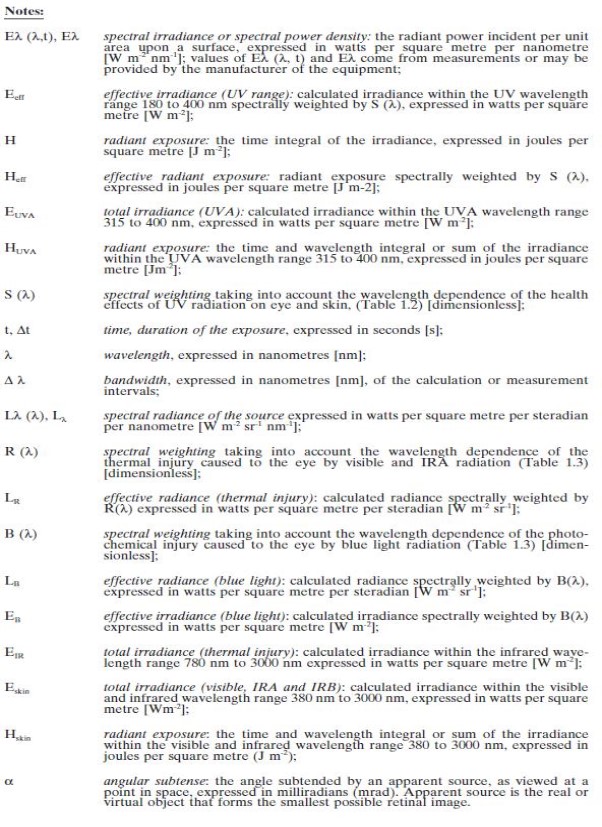
Table 1.1: Exposure limit values for non-coherent optical radiation
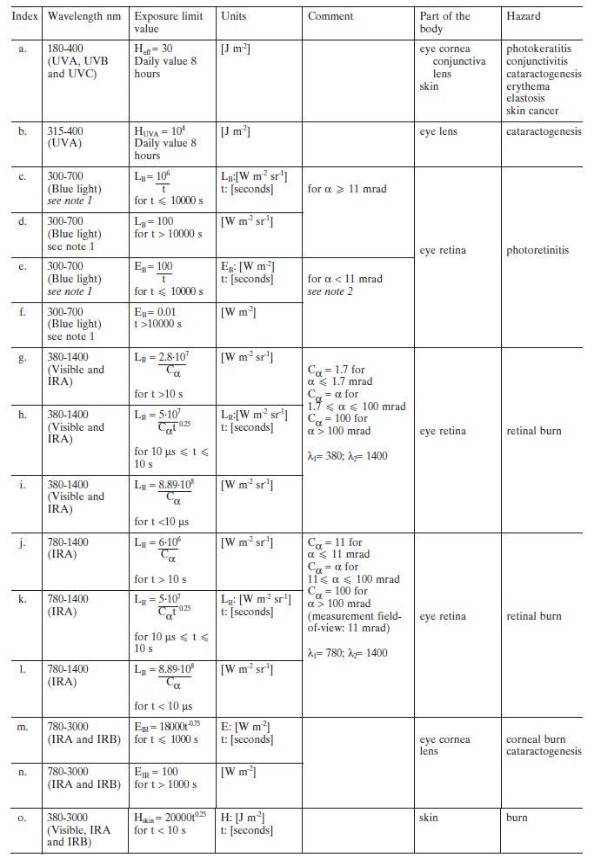
Note 1: The range of 300 to 700 nm covers parts of UVB, all UVA and most of visible radiation; however, the associated hazard is commonly referred to as blue light hazard. Blue light strictly speaking covers only the range of approximately 400 to 490 nm.
Note 2: For steady fixation of very small sources with an angular subtense < 11 mrad, L B can be converted to E B . This normally applies only for ophthalmic instruments or a stabilised eye during anaesthesia. The maximum “ stare time ” is found by:t max = 100 / E B with E B expressed in W m -2 . Due to eye movements during normal visual tasks this does not exceed 100 s.
Table 1.2: S () [dimensionless], 180 nm to 400 nm
|
λ in nm |
S ( λ ) |
λ in nm |
S ( λ ) |
λ in nm |
S ( λ ) |
λ in nm |
S ( λ ) |
λ in nm |
S ( λ ) |
|
180 |
0.0120 |
228 |
0.1737 |
276 |
0.9434 |
324 |
0.000520 |
372 |
0.000086 |
|
181 |
0.0126 |
229 |
0.1819 |
277 |
0.9272 |
325 |
0.000500 |
373 |
0.000083 |
|
182 |
0.0132 |
230 |
0.1900 |
278 |
0.9112 |
326 |
0.000479 |
374 |
0.000080 |
|
183 |
0.0138 |
231 |
0.1995 |
279 |
0.8954 |
327 |
0.000459 |
375 |
0.000077 |
|
184 |
0.0144 |
232 |
0.2089 |
280 |
0.8800 |
328 |
0.000440 |
376 |
0.000074 |
|
185 |
0.0151 |
233 |
0.2188 |
281 |
0.8568 |
329 |
0.000425 |
377 |
0.000072 |
|
186 |
0.0158 |
234 |
0.2292 |
282 |
0.8342 |
330 |
0.000410 |
378 |
0.000069 |
|
187 |
0.0166 |
235 |
0.2400 |
283 |
0.8122 |
331 |
0.000396 |
379 |
0.000066 |
|
188 |
0.0173 |
236 |
0.2510 |
284 |
0.7908 |
332 |
0.000383 |
380 |
0.000064 |
|
189 |
0.0181 |
237 |
0.2624 |
285 |
0.7700 |
333 |
0.000370 |
381 |
0.000062 |
|
190 |
0.0190 |
238 |
0.2744 |
286 |
0.7420 |
334 |
0.000355 |
382 |
0.000059 |
|
191 |
0.0199 |
239 |
0.2869 |
287 |
0.7151 |
335 |
0.000340 |
383 |
0.000057 |
|
192 |
0.0208 |
240 |
0.3000 |
288 |
0.6891 |
336 |
0.000327 |
384 |
0.000055 |
|
193 |
0.0218 |
241 |
0.3111 |
289 |
0.6641 |
337 |
0.000315 |
385 |
0.000053 |
|
194 |
0.0228 |
242 |
0.3227 |
290 |
0.6400 |
338 |
0.000303 |
386 |
0.000051 |
|
195 |
0.0239 |
243 |
0.3347 |
291 |
0.6186 |
339 |
0.000291 |
387 |
0.000049 |
|
196 |
0.0250 |
244 |
0.3471 |
292 |
0.5980 |
340 |
0.000280 |
388 |
0.000047 |
|
197 |
0.0262 |
245 |
0.3600 |
293 |
0.5780 |
341 |
0.000271 |
389 |
0.000046 |
|
198 |
0.0274 |
246 |
0.3730 |
294 |
0.5587 |
342 |
0.000263 |
390 |
0.000044 |
|
199 |
0.0287 |
247 |
0.3865 |
295 |
0.5400 |
343 |
0.000255 |
391 |
0.000042 |
|
200 |
0.0300 |
248 |
0.4005 |
296 |
0.4984 |
344 |
0.000248 |
392 |
0.000041 |
|
201 |
0.0334 |
249 |
0.4150 |
297 |
0.4600 |
345 |
0.000240 |
393 |
0.000039 |
|
202 |
0.0371 |
250 |
0.4300 |
298 |
0.3989 |
346 |
0.000231 |
394 |
0.000037 |
|
203 |
0.0412 |
251 |
0.4465 |
299 |
0.3459 |
347 |
0.000223 |
395 |
0.000036 |
|
204 |
0.0459 |
252 |
0.4637 |
300 |
0.3000 |
348 |
0.000215 |
396 |
0.000035 |
|
205 |
0.0510 |
253 |
0.4815 |
301 |
0.2210 |
349 |
0.000207 |
397 |
0.000033 |
|
206 |
0.0551 |
254 |
0.5000 |
302 |
0.1629 |
350 |
0.000200 |
398 |
0.000032 |
|
207 |
0.0595 |
255 |
0.5200 |
303 |
0.1200 |
351 |
0.000191 |
399 |
0.000031 |
|
208 |
0.0643 |
256 |
0.5437 |
304 |
0.0849 |
352 |
0.000183 |
400 |
0.000030 |
|
209 |
0.0694 |
257 |
0.5685 |
305 |
0.0600 |
353 |
0.000175 |
||
|
210 |
0.0750 |
258 |
0.5945 |
306 |
0.0454 |
354 |
0.000167 |
||
|
211 |
0.0786 |
259 |
0.6216 |
307 |
0.0344 |
355 |
0.000160 |
||
|
212 |
0.0824 |
260 |
0.6500 |
308 |
0.0260 |
356 |
0.000153 |
||
|
213 |
0.0864 |
261 |
0.6792 |
309 |
0.0197 |
357 |
0.000147 |
||
|
214 |
0.0906 |
262 |
0.7098 |
310 |
0.0150 |
358 |
0.000141 |
||
|
215 |
0.0950 |
263 |
0.7417 |
311 |
0.0111 |
359 |
0.000136 |
||
|
216 |
0.0995 |
264 |
0.7751 |
312 |
0.0081 |
360 |
0.000130 |
||
|
217 |
0.1043 |
265 |
0.8100 |
313 |
0.0060 |
361 |
0.000126 |
||
|
218 |
0.1093 |
266 |
0.8449 |
314 |
0.0042 |
362 |
0.000122 |
||
|
219 |
0.1145 |
267 |
0.8812 |
315 |
0.0030 |
363 |
0.000118 |
||
|
220 |
0.1200 |
268 |
0.9192 |
316 |
0.0024 |
364 |
0.000114 |
||
|
221 |
0.1257 |
269 |
0.9587 |
317 |
0.0020 |
365 |
0.000110 |
||
|
222 |
0.1316 |
270 |
1.0000 |
318 |
0.0016 |
366 |
0.000106 |
||
|
223 |
0.1378 |
271 |
0.9919 |
319 |
0.0012 |
367 |
0.000103 |
||
|
224 |
0.1444 |
272 |
0.9838 |
320 |
0.0010 |
368 |
0.000099 |
||
|
225 |
0.1500 |
273 |
0.9758 |
321 |
0.000819 |
369 |
0.000096 |
||
|
226 |
0.1583 |
274 |
0.9679 |
322 |
0.000670 |
370 |
0.000093 |
||
|
227 |
0.1658 |
275 |
0.9600 |
323 |
0.000540 |
371 |
0.000090 |
Table 1.3: B (), R () [dimensionless], 380 nm to 1400 nm
|
λ in nm |
B ( λ ) |
R ( λ ) |
|
300 ≤ λ < 380 |
0.01 |
— |
|
380 |
0.01 |
0.1 |
|
385 |
0.013 |
0.13 |
|
390 |
0.025 |
0.25 |
|
395 |
0.05 |
0.5 |
|
400 |
0.1 |
1 |
|
405 |
0.2 |
2 |
|
410 |
0.4 |
4 |
|
415 |
0.8 |
8 |
|
420 |
0.9 |
9 |
|
425 |
0.95 |
9.5 |
|
430 |
0.98 |
9.8 |
|
435 |
1 |
10 |
|
440 |
1 |
10 |
|
445 |
0.97 |
9.7 |
|
450 |
0.94 |
9.4 |
|
455 |
0.9 |
9 |
|
460 |
0.8 |
8 |
|
465 |
0.7 |
7 |
|
470 |
0.62 |
6.2 |
|
475 |
0.55 |
5.5 |
|
480 |
0.45 |
4.5 |
|
485 |
0.32 |
3.2 |
|
490 |
0.22 |
2.2 |
|
495 |
0.16 |
1.6 |
|
500 |
0.1 |
1 |
|
500 < λ ≤ 600 |
10 0.02 · (450- λ ) |
1 |
|
600 < λ ≤ 700 |
0.001 |
1 |
|
700 < λ ≤ 1050 |
— |
10 0.002 · (700- λ ) |
|
1050 < λ ≤ 1150 |
— |
0.2 |
|
1150 < λ ≤ 1200 |
— |
0.210 0.02 · (1150- λ ) |
|
1200 < λ ≤ 1400 |
— |
0.02 ] |
F84 [ Part 2
Laser Optical Radiation
The biophysically relevant exposure values to optical radiation can be determined with the formulae below. The formulae to be used depend on the wavelength and duration of radiation emitted by the source and the results should be compared with the corresponding exposure limit values indicated in the Tables 2.2 to 2.4. More than one exposure value and corresponding exposure limit can be relevant for a given source of laser optical radiation.
Coefficients used as calculation tools within the Tables 2.2 to 2.4 are listed in Table 2.5 and corrections for repetitive exposure are listed in Table 2.6.
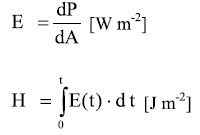
|
Notes: |
|
|
dP |
power expressed in watt [W]; |
|
dA |
surface expressed in square metres [m2]; |
|
E ( t ), E |
irradiance or power density : the radiant power incident per unit area upon a surface, generally expressed in watts per square metre [W m -2 ]. Values of E( t ), E come from measurements or may be provided by the manufacturer of the equipment; |
|
H |
radiant exposure : the time integral of the irradiance, expressed in joules per square metre [Jm -2 ]; |
|
t |
time, duration of the exposure , expressed in seconds [s]; |
|
λ |
wavelength , expressed in nanometres [nm]; |
|
γ |
limiting cone angle of measurement field-of-view expressed in milliradians [mrad]; |
|
γ m |
measurement field of view expressed in milliradians [mrad]; |
|
α |
angular subtense of a source expressed in milliradians [mrad]; |
|
limiting aperture : the circular area over which irradiance and radiant exposure are averaged; |
|
|
G |
integrated radiance : the integral of the radiance over a given exposure time expressed as radiant energy per unit area of a radiating surface per unit solid angle of emission, in joules per square metre per steradian [Jm -2 sr -1 ]. |
Table 2.1: Radiation hazards
|
Wavelength [nm] λ |
Radiationrange |
Affected organ |
Hazard |
Exposure limit value table |
|
180 to 400 |
UV |
eye |
photochemical damage and thermal damage |
2.2, 2.3 |
|
180 to 400 |
UV |
skin |
erythema |
2.4 |
|
400 to 700 |
visible |
eye |
retinal damage |
2.2 |
|
400 to 600 |
visible |
eye |
photochemical damage |
2.3 |
|
400 to 700 |
visible |
skin |
thermal damage |
2.4 |
|
700 to 1400 |
IRA |
eye |
thermal damage |
2.2, 2.3 |
|
700 to 1400 |
IRA |
skin |
thermal damage |
2.4 |
|
1400 to 2600 |
IRB |
eye |
thermal damage |
2.2 |
|
2600 to 10 6 |
IRC |
eye |
thermal damage |
2.2 |
|
1400 to 10 6 |
IRB. IRC |
eye |
thermal damage |
2.3 |
|
1400 to 10 6 |
IRB. IRC |
skin |
thermal damage |
2.4 |
Table 2.2 Exposure limit values for laser exposure to the eye Short exposure duration < 10 s
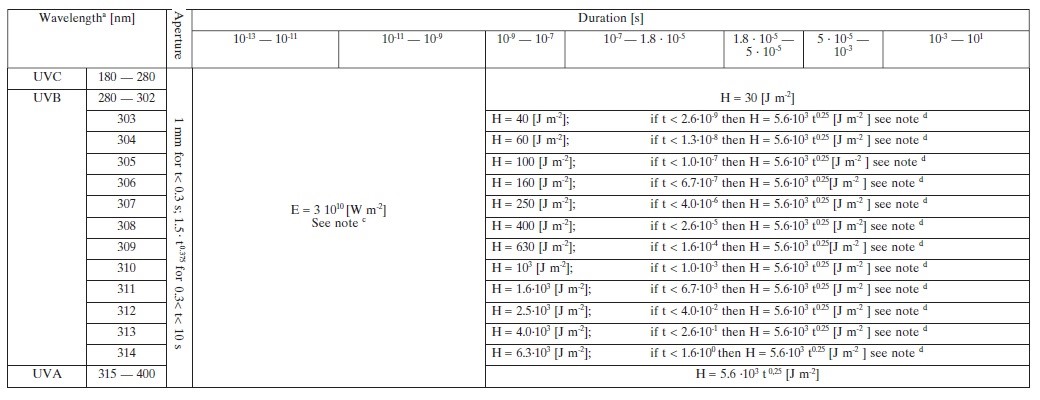

a If the wavelength of the laser is covered by two limits, then the more restrictive applies.
b When 1400 < 10 5 nm: aperture diameter = 1 mm for t 0.3 s and 1.5 t 0.375 mm for 0.3 s < t < 10 s; when 10 5 < 10 6 nm: aperture diameter = 11 mm.
c Due to lack of data at these pulse lengths, ICNIRP recommends the use of the 1 ns irradiance limits.
d The table states values for single laser pulses. In case of multiple laser pulses, then the laser pulse durations of pulses falling within an interval Tmin (listed in table 2.6) must be added up and the resulting time value must be filled in for t in the formula: 5.6 10 3 t 0.25
Table 2.3 Exposure limit values for laser exposure to the eye — Long exposure duration 10 s
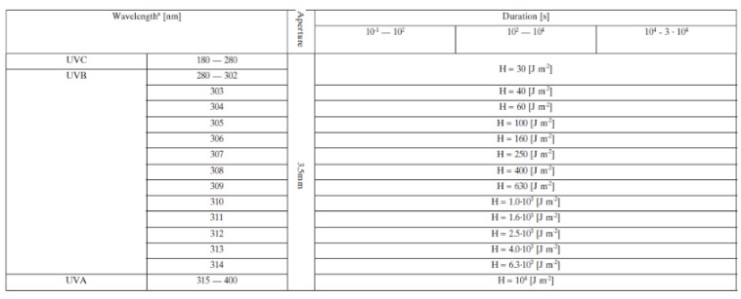

a If the wavelength or another condition of the laser is covered by two limits, then the more restrictive applies.
b For small sources subtending an angle of 1.5 mrad or less, the visible dual limits E from 400 nm to 600 nm reduce to the thermal limits for 10 s ≤ t<T 1 and to photochemical limits for longer times. For T 1 and T 2 see Table 2.5. The photochemical retinal hazard limit may also be expressed as a time integrated radiance G = 10 6 C B [J m -2 sr -1 ] for t > 10s up to t = 10000 s and L=100 C B [W m -2 sr -1 ] for t> 10000 s. For the measurement of G and L γ m must be used as averaging field of view. The official border between visible and infrared is 780 nm as defined by the CIE. The column with wavelength band names is only meant to provide better overview for the user. (The notation G is used by CEN; the notation L t is used by CIE; the notation L P is used by IEC and CENELEC.)
c For wavelength 1400 — 10 5 nm: aperture diameter = 3.5 mm; for wavelength 10 5 — 10 6 nm: aperture Diameter = 11 mm.
d For measurement of the exposure value the consideration of γ is defined as follows: If α (angular subtense of a source) > γ (limiting cone angle, indicated in brackets in the corresponding column) then the measurement field of view γ m should be the given value of γ . (If a larger measurement field of view is used, then the hazard would be overestimated). If α < γ then the measurement field of view γ m must be large enough to fully enclose the source but is otherwise not limited and may be larger than γ .
Table 2.4: Exposure limit values for laser exposure of skin
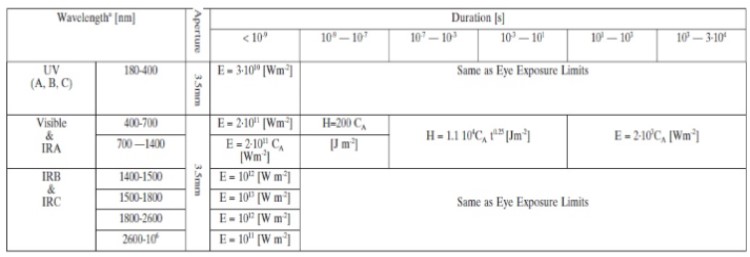
a If the wavelength or another condition of the laser is covered by two limits, then the more restrictive applies
Table 2.5: Applied correction factors and other calculation parameters
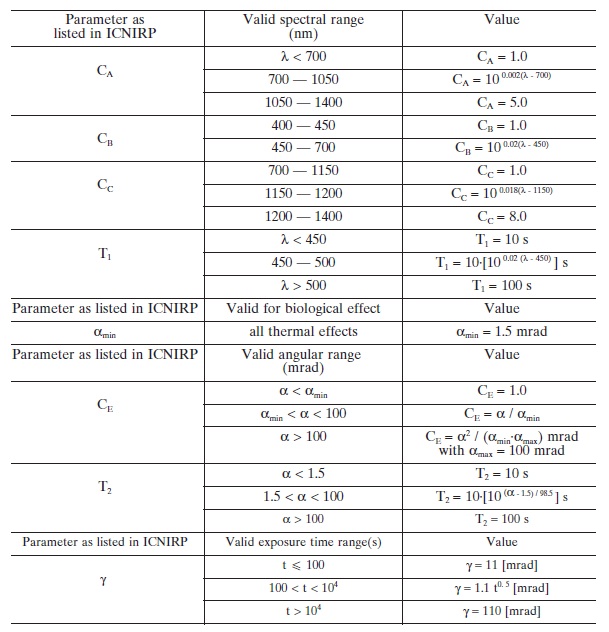
Table 2.6 Correction for repetitive exposure
Each of the following three general rules should be applied to all repetitive exposures as occur from repetitively pulsed or scanning laser systems:
1. The exposure from any single pulse in a train of pulses shall not exceed the exposure limit value for a single pulse of that pulse duration.
2. The exposure from any group of pulses (or sub-group of pulses in a train) delivered in time t shall not exceed the exposure limit value for time t.
3. The exposure from any single pulse within a group of pulses shall not exceed the singlepulse exposure limit value multiplied by a cumulative-thermal correction factor Cp=N-0.25, where N is the number of pulses. This rule applies only to exposure limits to protect against thermal injury, where all pulses delivered in less than Tmin are treated as a single pulse.
 ]
]
F85 [ Part 3
Assessment, Measurement and Calculation of Exposure
The methodology applied in assessment, measurement and/or calculations shall follow the standards of the International Electrotechnical Commission (IEC) in respect of laser radiation and the recommendations of the International Commission on Illumination (CIE) and the European Committee for Standardisation (CEN) in respect of non-coherent radiation.
In exposure situations which are not covered by these standards and recommendations, and until appropriate EU standards or recommendations become available, assessment, measurements and/or calculations shall be carried out using available international science-based guidelines. In both exposure situations, the assessment may take account of data provided by the manufacturers of the equipment when it is covered by relevant Community Directives. ]

